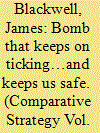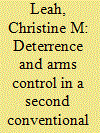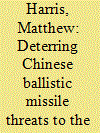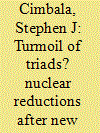| Srl | Item |
| 1 |
ID:
142789


|
|
|
|
|
| Summary/Abstract |
The United States Air Force has returned from its nuclear modernization and intellectual holidays. The B61 Life Extension Program and nuclear capability for the F-35 fighter are at the leading edge of a flight plan that vectors the institution to rebuild the nation's extended deterrent; its two legs of our strategic triad; and nearly all nuclear command, control, and communications infrastructure, to deter emerging nuclear threats and assure allies new and old. This flight plan is framed by new efforts across the cognitive domain of war so that all airmen understand how vastly different twenty-first century deterrence is from the Cold War.
|
|
|
|
|
|
|
|
|
|
|
|
|
|
|
|
| 2 |
ID:
142786


|
|
|
|
|
| Summary/Abstract |
Neither further nuclear reductions nor total nuclear disarmament are necessarily smart ideas, but proponents of these goals insist that we should move toward a second conventional age, in which nuclear weapons are either marginalized or completely removed from international politics. But in this world, deterrence and extended deterrence might not endure without boosting aspects of conventional arsenals. How might the U.S. deter adversaries and assure allies? The answer ultimately rests on conventional forces, especially long-range ballistic and cruise missiles. But these would have to be deployed in greater numbers to compensate for a “nuclear gap.” This might lead to a destabilizing arms race.
|
|
|
|
|
|
|
|
|
|
|
|
|
|
|
|
| 3 |
ID:
142788


|
|
|
|
|
| Summary/Abstract |
The Chinese government has made great strides to creating an improved and increasingly capable nuclear arsenal. Despite these developments and deployments, the U.S. government continues to rely on dialogue and strategic stability to deter U.S.-Chinese war. This sole reliance on offensive strategic forces fails to adequately protect the American people from Chinese ballistic missile threats, especially ones armed with nuclear weapons. Preventing a Chinese nuclear weapon from annihilating U.S. cities will do more for deterring nuclear war than emphasizing dialogue and strategic stability while the Chinese government continues to modernize and expand its nuclear arsenal.
|
|
|
|
|
|
|
|
|
|
|
|
|
|
|
|
| 4 |
ID:
142787


|
|
|
|
|
| Summary/Abstract |
China's nuclear weapons modernization during the last 25 years has spawned analyses regarding the strategic intent behind these technological developments, to include the possibility of a Chinese challenge to U.S. military superiority in the Asia–Pacific region. Yet analysis of the historical development trajectory of China's nuclear weapons program suggests it was never intended to support a direct military challenge. Indeed, after developing a nuclear-weapons capability in the 1960s, China produced only a small number of vulnerable nuclear weapons against the expectation of nuclear deterrence theory and despite confrontational relations with both nuclear superpowers. To explain China's nuclear choices, I utilize newly available information to argue that China's Mao-era strategic culture—with its emphasis on conventional weaponry utilized according to People's War principles—limited the initial scope of its nuclear weapons program.
|
|
|
|
|
|
|
|
|
|
|
|
|
|
|
|
| 5 |
ID:
142790


|
|
|
|
|
| Summary/Abstract |
The United States and Russia have options for resuming their strategic nuclear arms reductions, should more favorable political circumstances present themselves. Both share a responsibility for leadership in the global nonproliferation regime, and both the U.S. and Russia will face future trade-offs between domestic economic priorities and nuclear force modernization. Analysis suggests that reductions to a maximum number of 1,000 deployed nuclear weapons on intercontinental launchers for each state should allow for sufficient numbers of second-strike-survivable weapons for stable deterrence. Below that number, either the U.S. or Russia might feel a sense of insufficient flexibility and resilience in its strategic nuclear forces, and in addition, reductions significantly below 1,000 deployed weapons would require the participation of other nuclear weapons states.
|
|
|
|
|
|
|
|
|
|
|
|
|
|
|
|